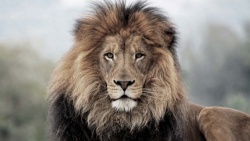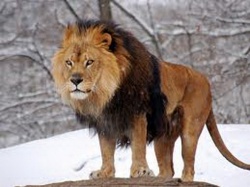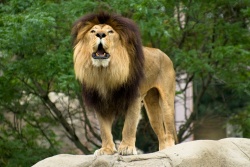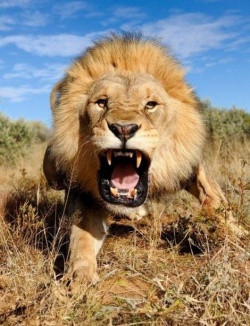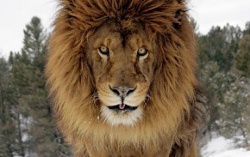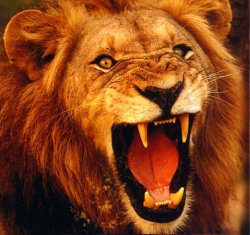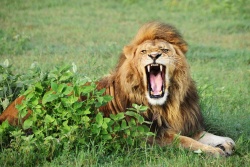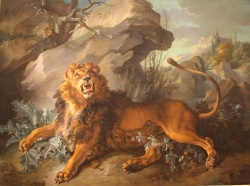The Lion Symbol In Indo-Tibetan Martial Arts
The Lion as a symbol and theriomorphic (animal representation or projection) image is found at the very heart of Buddhism.
The first historical Buddha: Shakyamuni, popularly known as Siddhartha Gautama, was called The Lion of Shakya's (his clan). Shakyamuni's Grandfather was called Simhananu (The Lion of Reliability). It was usual for the term Simha to be applied to a name to indicate a Warrior Lineage within the family, a Ksatreya - Warrior family.
On Shakyamuni's birth it was said, he stood upright pointing one finger to Heaven and one to Earth, letting out a Roar like a Lion, announcing his arrival (circa 6th Century B.C.E.)
The Simhanada meaning 'Lion's Roar!' (in Japanese: Shiku) is made up from the Sanskrit particles Simha (Lion) and Nada (Roar!). Nada also means the Battle-Cry of a Warrior.
When he was 7 years old, Shakyamuni was instructed by his teachers: Arata, Kalama, Kshantideva and Rudrakarama in the Pancavididya (The Five Arts of the Warrior Kshatriya's). Kshantideva in particular is said to have instructed Shakyamuni in the martial arts of Grappling: (Malla-Yuddam) Boxing: (Mushti) Weaponry and Gymnastics - all together called the Simhavikridatta (Lion's Skill) of the Vajramushti Diamond-Thinderbolt Fist Martial Art - the Fighting Art of the Kshatriya Warriors. Indeed Lion's Skill was synonymous with Vajramushti/Vajramukti hence: Simhanda Vajramushti - and eventually, Tibetan Lion's Roar! "Kung-Fu".
The Buddha is often depicted in religious art as seated on his Lotus-Lion Throne with 4 pairs of Lions at the base - each pair facing in one of the four cardinal directions.
Long before, the Lion was a central image in Indian religion, being associated with Royalty in general, and especially as a theriomorph, avatar or vehicle (Sanskrit: Vahana) of the Gods. For example, the 4th Avatar of Lord Vishnu is called Narasimha and is part Lion part Man - Simhan is Sanskrit for Lion:
"All glories to you, O Lord of the universe, who took the form of a man-lion. As easily as crushing a wasp between your fingers, you tore apart the demon Hiranyakashipu with the pointed nails of your bare hands, which are beautiful like the lotus flower".
The brother of Hiranyaksha was another demon named Hiranyakashipu. When he saw that Hiranyaksha had been killed by Vishnu he swore vengeance. With blazing eyes he called all his associates together and vowed, "I will kill Vishnu and sever his head from his body. You all go down to earth and attack the brahmanas and devotees of Vishnu. Wherever cows are protected set fire to the houses and cut down the trees."
Vedic culture places special importance on the welfare of brahmanas (spiritual teachers), cows and trees. Hiranyakashipu knew that if they attacked these three they would be destroying all that was most dear to Vishnu. Hiranyakashipu then set about becoming the most powerful person in the universe, trampling all beneath him and spreading a reign of terror. But always he was searching for Vishnu to kill him. He tried to force Brahma, chief of the demigods, to make him immortal. Brahma, however, could not do that because even he had to die eventually. So instead the demon extracted from him various assurances: he would not die during the day or the night; on land, at sea or in the sky; inside or outside; by the hands of human or beast; or by any weapon. Now, he thought, he was immortal!
In due course Hiranyakashipu had a son. The boy turned out to be quite different from his father - he was a devotee of Vishnu. His name was Prahlad. From the beginning of his life Prahlad spread light and love around him. His father tried every possible way to turn the boy into a demon like him, but nothing worked. Unable to tolerate a member of his family worshipping his mortal enemy, he decided to kill his own son. But it was not easy. He gave him to his soldiers to execute, but they couldn't do it. He tried throwing him off a cliff, crushing him beneath an elephant, putting him amongst venomous snakes and poisoning his food. Nothing would work. Prahlad's life was protected by some supernatural force. Finally in anger Hiranyakashipu demanded, "Where do you get your strength?"
"From the same place you get yours, father, from Vishnu."
"Where is this Vishnu of yours! Let me see him so that I can kill him!"
"He's everywhere!" replied Prahlad.
"Then he's in this pillar," cried the demon, and rushing at a nearby pillar of the palace struck it a terrible blow. At that moment a fearful sound came from the pillar, as if the universe itself was about to split apart. All who heard it were afraid. The pillar burst asunder and a terrifying form emerged from it - with the head of a lion and the body of a man. This was Narasimha, the man-lion incarnation of Vishnu, who had come to protect his devotee, Prahlad. Hiranyakashipu tried to attack him, as an insect flies into a fire. After a brief struggle, Narasimha picked up the demon and killed him.
He was killed at the point of dusk, neither day nor night; he was on the lap of Vishnu, neither land nor air nor sea; his death took place on the threshold of the palace, neither inside nor outside; he was killed by the Lord's nails, not by any weapon; he died at the hands of neither human nor animal, but half-man, half-lion. Thus Narasimha-Vishnu, whilst keeping all the conditions of Brahma, still killed the demon Hiranyaksha, who had so cruelly tried to end the life of his devotee Prahlad. After his death, Hiranyakashipu was freed from his hatred of Vishnu. Being purified by Narasimha's touch, he gained liberation from the cycle of birth and death.
Whenever they hear the roar of a lion, devotees of Vishnu remember how Narasimha rescued Prahlad and if there is danger, they pray to Narasimha for protection".
NOTE THE ROLE OF NARASIMHA IN TANTRIC MARTIAL ARTS:
Below is interesting, as an example of Lion Symbolism, and, of working the Psychic Bardo- Field with Narasimha as a 'Yidam' to strengthen the connection to the 'inner Lion' and its Roar!
The following is a short description of Vishnu in his Avatar as the 'Man-Lion'. Note his 'Bardo' state as Half-Man, Half-Lion Also, his action is at cross-over points and times (Antarala's/Bardo's)
From this, we can utilize appropriate imagery as the Man-Lion - as in a Yidam process, to work Tantrically in the Bardo-States:
"The Man-Lion (Narasimha): a demon had been granted the boon that it could not be killed by man or animal; inside or outside its house; by day or by night. It roamed the world causing distress and chaos. Vishnu became half-man, half-lion to kill the demon. He was neither man nor animal. He executed the demon on its threshold, neither in nor out of the house, at sunset - neither day nor night".
Vishnu (Krishna) is a Hindu deity, but, there is no problem with working him as a Yidam in a 'Buddhist' sense, or indeed a Hindu one, as Hinduism is open to all branches of religion.
Narasimha can remind us of the Bardo state between 'human' ego identified consciousness (the 'little ego self or atman with a small 'a') and a theriomorph - a mixed animal or full animal level of consciousness. In Lion's Roar! we utilize the cross-modal Bardo states of mind to tap into transformative powers.
Today, many followers of the Sikh Religion are surnamed Singh (Northern India pronunciation for Lion) - which incidentally is very close to the Tibetan form: Senga or Sen-ge.
"The Lion's Roar" went on to make appearance in the Buddha's Lotus Sutra:
The Buddha's are depicted as seated on Jeweled Lion Thrones, and in Chapter 13, the Lion's Roar itself is heard;
From Chapter 13 of The Lotus Sutra:
- "At that time the bodhisattvas, respectfully complying with the Buddha's will and at the same time wishing to fulfill their own original vows, proceeded in the presence of the Buddha to Roar the Lion's Roar! and to make a vow, saying: "World-Honored One, after the Thus Come One has entered extinction we will travel here and there, back and forth through the worlds in the ten directions so as to enable living beings to copy this sutra, receive, embrace, read and recite it, understand and preach its principles, practice it in accordance with the Law, and properly keep it in their thoughts. All this will be done through the Buddha's power and authority. We beg that the World-Honored One, though in another region, will look on from afar and guard and protect us".
It has been suggested that the ancestors of the Shakaya's clan (The Buddha's blood line) came from Central Asia, where as noted by the ancient Persian's the Lion still roamed the land. Indeed it may have been their (the Shakaya's) Totem animal, just as it was with the Mycenaean Greeks of the 2nd Milenium B.C.E.
The Lion is the animal most associated with the Buddha in all cultures, and he is still referred to as: The Lion of The Shakaya's. The golden hue of the Lion's coat is said to be reminiscent of the golden complexion of Shakyamuni Buddha himself.
A further suggestion has been made that the Lion's Roar (as a martial art) is in fact of Sufi (Islamic-Mystic) origin, perhaps even older, rooting back into the Persian mystery religions and Zoroastrianism (circa 600 B.C.E.) There is a Sufi Sutra that mentions the 'Lion's Roar', and is said to have been authored by someone with the same name as that of the Tibetan Lion's Roar martial arts founder: Ah-Dat-Tor.
The near-contemporary Buddhist teacher Chogyam Trugpa Rinpoche, who re-introduced the Tantric Buddhist system to Western students in the 1960's described the significance of the 'Lions Roar' as follows:
"The Lion's Roar! is the fearless proclamation that whatever comes up in our state of mind, including powerful emotions, is workable"
The Lion's Roar martial art, founded as 'An overwhelming martial art, full of grace and power' does indeed use such powerful emotions, and in fact they are known to spontaneously arise during its practice - quite autonomously and to a very marked degree.
By the time of the accepted founding of the 'Tibetan' Lion's Roar martial art (Circa 1426 .C.E.) indigenous Tibetan martial arts (e.g. Amaree - 'wrestling') had been heavily influenced by the Indian martial arts of Kalari Pyatt and Vajramukti. Indeed even today techniques in the various branches of the Lion's Roar art as taught in China and the West resemble many of the movements and even sequences of 'Forms' (Sanskrit 'Nata') still taught in Kalari. Also, "Simhanada Vajramushti" is an acceptable Sanskrit transliteration of the Tibetan 'Senge-Ngwa Dorje-Lag-Pa' - in English: 'The Lion's Roar! - Diamond-Thunderbolt Fist'. This shows the relationship between Indian Tantra, Tibetan Tantra, and their respective Martial Arts.
The Lion's Roar! Martial Art IS The Diamond Thunderbolt Fist of Tantra.
The name 'Lion's Roar' refers to the Buddha's proclamation of the Dharma (Law) and to the vow taken by the Arhat disciples before the Buddha in the Lotus Sutra - to the lineage back thru India to the Buddha's blood line family - the Shakaya's, and their Lion's Roar! Battle-Cry as Warriors. This blood line and spiritual ancestry has very deep roots earlier than historical Buddhism, in Hinduism as Narasimha, and in connection with Kali (see link: Hindu Kali and the Lion Symbol and perhaps also in 'Persian' mystery religions. It is also the the name of one of the 8 Manifestations of the Indian Guru: Padmasabhava - "The "Lotus Born: the revered 1st Patriarch of Vajrayana Buddhism to Tibet. The name 'Lion's Roar' in the Tibetan Lion's Roar Lama Martial Art is inextricably linked thru Tantra, to Senge Dradog as the 'Lion's Roar! Guru': Padmasabhava.
The image of the Lion in Tibet is very important, the mythical 'Snow Lion' is a national symbol of Tibet, a pair of Snow Lion's appear on the Tibetan National Flag. The Dalai Lama's sit on the 'Lion Throne'. The Lion symbol is central to many Tibetan Dorje-Tantric (Vajrayana) Buddhist rituals and meditations.
Lama Jigme Rinpoche of the Tibetan Kagyu Tantric Lineage says:
" In the future, the 6th Buddha will continue Karmapa's activities. Buddha Sakyamuni was the 4th historical Buddha; the next will be Maitreya (Mi-Lo-Fo in Han Chinese) The 6th Buddha will carry the name Singhe, which means "Lion." So Karmapa will appear under the name Singhe. He will teach in the same way as the Buddha Sakyamuni and continue with his bodhisattva form" (1989)
The Sixth Historical Buddha will therefore carry the name of the Lion!
The founding 'experience' of Ah-Dat-Tor Lama - a Vajrayana (Tantric) Buddhist Monk, was a vision (more likely a Tantric Yidam meditation and/or 'revealed wisdom' of a hidden treasure or 'Terma':) of combat between a Crane and an Ape. The Ape is the mythological 'Father' of the Tibetan Nation and People, the Crane (a 'Sarus' White Crane) is important too in Tibet, but even more so in India and in China.
It is sometimes claimed that Ah-Dat-Tor Lama was not an ethnic Tibetan, but a Han (Chinese) from Quinghai Province in Western China. This is possible, but no original primary source documentation exists to prove it either way. The extant documentations are relatively recent, and written down as recorded from Han cultural narratives. The original written Tibetan sources, if they ever existed in 'written' form remain at least for the moment - lost (note Padma's Treasures 'Terma' may be discovered by a Tetron or 'treasure seeker' in any form as 'revealed wisdom', and that these may be 'hidden' inside the mind 'Citta' of reincarnated disciples - now treasure-seekers- awaiting their instantiation as direct teachings). Ah-Dat-Tor, whose name translated into Han-Chinese 阿达陀 implies a 'realized' one, who then teaches, which is the function of a Tetron who has uncovered a Terma-treasure of Guru Rinpoche Padmasambhava.
Nevertheless, many Lama-Monks were native Chinese, Mongolians or Manchurians as well as Tibetan's, so it is possible for Ah-Dat-Tor to have been a native Chinese. Ah-Dat-Tor's nationality or ethnicity is not relevant to his role as a Tantric Tetron, a realized Guru, who is obliged to teach the revealed wisdom of Padma's Treasures. Revelation transcends national and cultural boundaries.
However, in the current political climate vis-a-vis China and Tibet, it is important for some Chinese to overstate the claim that Ah-Dat-Tor was Chinese. It has also been common Han-chinese practice, to overwrite the influence of Indian culture on 'their' (Han) indigenous martial arts.
The really important thing historically, is the pure and solid connection to both Hinduism and Buddhism summed up in the name 'Lion's Roar'. Many of the techniques, and specifically the numeric qualities ascribed e.g. the numbers 4, 6, 8 hold all the information necessary to understand the esoteric connections to Hinduism and Tantric Buddhism that are required to be present in order to understand this art.
The Lion's Roar then takes us back thru religion, culture and pure applied martial arts, back thru Tibet, into Northern India as Simhanada Vajra-Mukti, to Southern India's Kalari martial art, back onwards perhaps even thru Persia to Central Asia.
The Ape and Crane may very well have come to symbolize the relationship between Tibet and China, hence the Chinese emphasis on the supposed 'victory' of the Crane (China) over the Ape (Tibet) in many Chinese versions of the Ah-Dat-Tor story.
However, the Sarus Crane's actual significance as a Tantric co-totem consciousness theriomorph, may in fact be in the much earlier political and religious (and martial) relationship between Tibet and India, and even earlier still as a relationship between Goddess Kali and Vajra-Hanuman.
Historically, the Lion's Roar martial art became a part of traditional 'Chinese' Kung-Fu - although today a project is underway to return this Tibetan system back to its homeland Nation and People, and to acknowledge the true roots of this High Tantric Martial Art as INDO-TIBETAN.
Let us therefore in honor of the Lord Buddha, neither forget, nor neglect, the Lion and its ROAR!
Sanskrit & Chinese Translations of 師子吼 : 獅子吼 "Lion's Roar"
師 ("Si") A host, army; a leader, preceptor, teacher, model; tr. of upādhyāya, an 'under-teacher', generally interpreted as a Buddhist monk.
師 "Si" as in Si-Fu
子 "Ji" as in Seed, or Son (note the Buddha's Son's and Seeds, in relation to Lion's Roar! Tantric Buddhist Martial Arts symbolism.
師子 ("Si-Ji") Simha, a lion; also 獅子 Buddha, likened to the lion, the king of animals, in respect of his fearlessness.
師子乳 Lion's milk, like bodhi -enlightenment, which is able to annihilate countless ages of the karma of affliction, just as one drop of lion's milk can disintegrate an ocean of ordinary milk.
金毛獅子 The lion with golden hair on which Bodhisattva Mañjuśrī (Wenshu) rides; also a previous incarnation of the Buddha.
師子光 Simharaśmi. 'A learned opponent of the Yogācāra school who lived about A. D. 630.' Eitel.
師子吼 ("Si-Ji-Hao") also: 獅子吼: Simhanāda. The lion's roar, a term designating authoritative or powerful preaching. As the lion's roar makes all animals tremble, subdues elephants, arrests birds in their light and fishes in the water, so Buddha's preaching overthrows all other religions, subdues devils, conquers heretics, and arrests the misery of life.
佛吼 Buddha's nāda, or roar, Buddha's preaching compared to a lion's roar
師子國 Simhala, Ceylon, the kingdom reputed to be founded by Simha, first an Indian merchant, later king of the country, who overcame the 'demons' of Ceylon and conquered the island.
師子座 (or 師子牀) Simhāsana. A lion throne, or couch. A Buddha throne, or seat; wherever the Buddha sits, even the bare ground; a royal throne.
師子奮迅 The lion aroused to anger, i.e. the Buddha's power of arousing awe.
師子尊者 師子比丘 Āryasimha, or Simha-bhiku. The 23rd or 24th patriarch, brahman by birth; a native of Central India; laboured in Kashmir, where he died a martyr A.D. 259.
師子王 Simhanadraja: The lion king, The Buddha.
師子相 Simdhadhvaja; 'lion-flag,' a Buddha south-east of our universe, fourth son of Mahābhijña.
師子冑 or 師子鎧 Harivarman, to whom the 成實論 Satyasiddhi-śāstra is ascribed.
師子身中蟲 Just as no animal eats a dead lion, but it is destroyed by worms produced within itself, so no outside force can destroy Buddhism, only evil monks within it can destroy it.
師子遊戲三昧 The joyous Samādhi which is likened to the play of the lion with his prey. When a Buddha enters this degree of Samādhi he causes the earth to tremble, and the purgatories to give up their inmates.
師子音 Simhaghoma; 'lion's voice,' a Buddha south-east of our universe, third son of Mahābhijña
師傅師子音 "Guru with a Lion's voice" also 師傅師子吼 or 師傅獅子吼 as "Guru Lion's Roar" BOTH names for Padmasambhava - the Lotus Born (called Guru Rinpoche) the Patriarch of Tantric Buddhism to Tibet.
